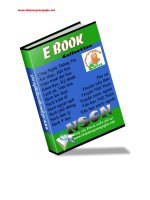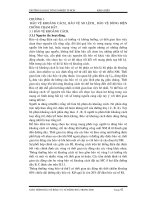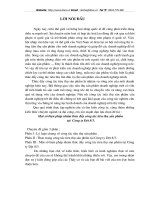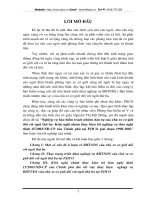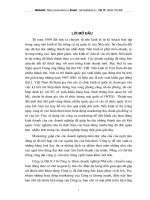3 unemployment
Bạn đang xem bản rút gọn của tài liệu. Xem và tải ngay bản đầy đủ của tài liệu tại đây (477.57 KB, 42 trang )
Unemployment and
Its Natural Rate
Copyright © 2004 South-Western
3
How Is Unemployment Measured?
• Labor Force
• The labor force is the total number of workers,
including both the employed and the unemployed.
• The BLS defines the labor force as the sum of the
employed and the unemployed.
Copyright © 2004 South-Western
How Is Unemployment Measured?
Copyright © 2004 South-Western
Figure 1 The Breakdown of the Population in 2016
Employed
Labor Force
(53.3 million)
Working age
(54.4 million)
Unemployed (2.6%)
Not in labor force
Copyright
© 2004 South-Western
Copyright©2003
Southwestern/Thomson
Learning
IDENTIFYING UNEMPLOYMENT
Copyright © 2004 South-Western
IDENTIFYING UNEMPLOYMENT
Copyright © 2004 South-Western
How Is Unemployment Measured?
• The unemployment rate is calculated as the
percentage of the labor force that is
unemployed.
Number unemployed
Unemployment rate =
100
Labor force
Copyright © 2004 South-Western
Copyright © 2004 South-Western
How Is Unemployment Measured?
• The labor-force participation rate is the
percentage of the adult population that is in the
labor force.
Labor force participation rate
Labor force
100
Adult population
Copyright © 2004 South-Western
How Is Unemployment Measured?
• A person is considered employed if he or she
has spent most of the previous week working at
a paid job.
• A person is unemployed if he or she is on
temporary layoff, is looking for a job, or is
waiting for the start date of a new job.
Copyright © 2004 South-Western
IDENTIFYING UNEMPLOYMENT
• Categories of Unemployment
• The problem of unemployment is usually divided
into two categories.
• The long-run problem and the short-run problem:
• The natural rate of unemployment
• The cyclical rate of unemployment
Copyright © 2004 South-Western
IDENTIFYING UNEMPLOYMENT
• Cyclical Unemployment
• Cyclical unemployment refers to the year-to-year
fluctuations in unemployment around its natural
rate.
• It is associated with with short-term ups and downs
of the business cycle.
Copyright © 2004 South-Western
IDENTIFYING UNEMPLOYMENT
• Natural Rate of Unemployment
• The natural rate of unemployment is unemployment
that does not go away on its own even in the long
run.
• It is the amount of unemployment that the economy
normally experiences.
Copyright © 2004 South-Western
Why Are There Always Some People
Unemployed?
• Frictional unemployment refers to the
unemployment that results from the time that it
takes to match workers with jobs. In other
words, it takes time for workers to search for
the jobs that are best suit their tastes and skills.
Copyright © 2004 South-Western
Why Are There Always Some People
Unemployed?
• Structural unemployment is the unemployment
that results because the number of jobs
available in some labor markets is insufficient
to provide a job for everyone who wants one.
Copyright © 2004 South-Western
JOB SEARCH
• Job search
• the process by which workers find appropriate jobs
given their tastes and skills.
• results from the fact that it takes time for qualified
individuals to be matched with appropriate jobs.
Copyright © 2004 South-Western
JOB SEARCH
• This unemployment is different from the other
types of unemployment.
• It is not caused by a wage rate higher than
equilibrium.
• It is caused by the time spent searching for the
“right” job.
Copyright © 2004 South-Western
Why Some Frictional Unemployment is
Inevitable
• Search unemployment is inevitable because the
economy is always changing.
• Changes in the composition of demand among
industries or regions are called sectoral shifts.
• It takes time for workers to search for and find
jobs in new sectors.
Copyright © 2004 South-Western
Public Policy and Job Search
• Government programs can affect the time it
takes unemployed workers to find new jobs.
• These programs include the following:
• Government-run employment agencies
• Public training programs
• Unemployment insurance
Copyright © 2004 South-Western
Public Policy and Job Search
• Government-run employment agencies give out
information about job vacancies in order to
match workers and jobs more quickly.
Copyright © 2004 South-Western
Public Policy and Job Search
• Public training programs aim to ease the
transition of workers from declining to growing
industries and to help disadvantaged groups
escape poverty.
Copyright © 2004 South-Western
Public Policy and Job Search
• Unemployment insurance is a government
program that partially protects workers’
incomes when they become unemployed.
• Offers workers partial protection against job losses.
• Offers partial payment of former wages for a
limited time to those who are laid off.
Copyright © 2004 South-Western
Public Policy and Job Search
• Unemployment insurance increases the amount
of search unemployment.
• It reduces the search efforts of the unemployed.
• It may improve the chances of workers being
matched with the right jobs.
Copyright © 2004 South-Western
Public Policy and Job Search
• Structural unemployment occurs when the
quantity of labor supplied exceeds the quantity
demanded.
• Structural unemployment is often thought to
explain longer spells of unemployment.
Copyright © 2004 South-Western
Public Policy and Job Search
• Why is there Structural Unemployment?
• Minimum-wage laws
• Unions
• Efficiency wages
Copyright © 2004 South-Western
